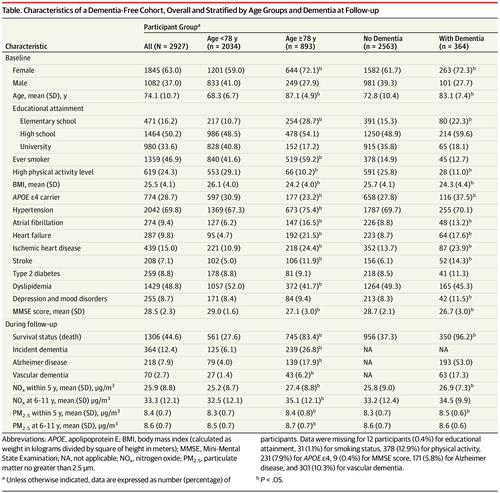JAMA Neurology ( IF 20.4 ) Pub Date : 2020-07-01 , DOI: 10.1001/jamaneurol.2019.4914 Giulia Grande 1 , Petter L S Ljungman 2, 3 , Kristina Eneroth 4 , Tom Bellander 2 , Debora Rizzuto 1, 5

|
Importance Emerging yet contrasting evidence associates air pollution with incident dementia, and the potential role of cardiovascular disease (CVD) in this association is unclear.
Objective To investigate the association between long-term exposure to air pollution and dementia and to assess the role of CVD in that association.
Design, Setting, and Participants Data for this cohort study were extracted from the ongoing Swedish National Study on Aging and Care in Kungsholmen (SNAC-K), a longitudinal population-based study with baseline assessments from March 21, 2001, through August 30, 2004. Of the 5111 randomly selected residents in the Kungsholmen district of Stockholm 60 years or older and living at home or in institutions, 521 were not eligible (eg, due to death before the start of the study or no contact information). Among the remaining 4590 individuals, 3363 (73.3%) were assessed. For the current analysis, 2927 participants who did not have dementia at baseline were examined, with follow-up to 2013 (mean [SD] follow-up time, 6.01 [2.56] years). Follow-up was completed February 18, 2013, and data were analyzed from June 26, 2018, through June 20, 2019.
Exposures Two major air pollutants (particulate matter ≤2.5 μm [PM2.5] and nitrogen oxide [NOx]) were assessed yearly from 1990, using dispersion models for outdoor levels at residential addresses.
Main Outcomes and Measures The hazard of dementia was estimated using Cox proportional hazards regression models. The potential of CVD (ie, atrial fibrillation, ischemic heart disease, heart failure, and stroke) to modify and mediate the association between long-term exposure to air pollution and dementia was tested using stratified analyses and generalized structural equation modeling.
Results At baseline, the mean (SD) age of the 2927 participants was 74.1 (10.7) years, and 1845 (63.0%) were female. Three hundred sixty-four participants with incident dementia were identified. The hazard of dementia increased by as much as 50% per interquartile range difference in mean pollutant levels during the previous 5 years at the residential address (hazard ratio [HR] for difference of 0.88 μg/m3 PM2.5, 1.54 [95% CI, 1.33-1.78]; HR for difference of 8.35 μg/m3 NOx, 1.14 [95% CI, 1.01-1.29]). Heart failure (HR for PM2.5, 1.93 [95% CI, 1.54-2.43]; HR for NOx, 1.43 [95% CI, 1.17-1.75]) and ischemic heart disease (HR for PM2.5, 1.67 [95% CI, 1.32-2.12]; HR for NOx, 1.36 [95% CI, 1.07-1.71]) enhanced the dementia risk, whereas stroke appeared to be the most important intermediate condition, explaining 49.4% of air pollution–related dementia cases.
Conclusions and Relevance This study found that long-term exposure to air pollution was associated with a higher risk of dementia. Heart failure and ischemic heart disease appeared to enhance the association between air pollution and dementia, whereas stroke seemed to be an important intermediate condition between the association of air pollution exposure with dementia.
中文翻译:

心血管疾病与长期暴露于空气污染与痴呆症的风险之间的关联。
重要性 新兴但相反的证据将空气污染与突发性痴呆相关联,目前尚不清楚心血管疾病(CVD)在这种关联中的潜在作用。
目的 探讨长期暴露于空气污染与痴呆之间的关系,并评估CVD在该关系中的作用。
设计,设置和参与者 这项队列研究的数据摘自正在进行的瑞典国家警察老年和护理研究(SNAC-K),这是一项基于人群的纵向研究,其基线评估从2001年3月21日至2004年8月30日。在5111个随机样本中斯德哥尔摩Kungsholmen区的60岁或60岁以上的特定居民以及在家中或机构中居住的人不符合资格(例如,由于在研究开始前已死亡或没有联系信息),有521位。在其余的4590个人中,评估了3363(73.3%)。对于当前的分析,对基线时没有痴呆症的2927名参与者进行了检查,并随访至2013年(平均[SD]随访时间为6.01 [2.56]年)。后续行动于2013年2月18日完成,分析了从2018年6月26日至2019年6月20日的数据。
暴露 从1990年开始,使用居民点室外水平的弥散模型,从1990年开始每年评估两种主要的空气污染物(≤2.5μm的颗粒物[PM 2.5 ]和氮氧化物[NO x ])。
主要结果和措施 使用Cox比例风险回归模型评估痴呆症的危害。使用分层分析和广义结构方程模型测试了CVD(即心房纤颤,缺血性心脏病,心力衰竭和中风)改变和介导长期暴露于空气污染与痴呆之间的关联的潜力。
结果 在基线时,2927名参与者的平均(SD)年龄为74.1(10.7)岁,女性为1845(63.0%)。确定了364名患有痴呆事件的参与者。在住址(危险比(HR)在过去5年痴呆的危险增加了每平均污染水平四分位范围差高达50%为0.88微克/立方米的差3 PM 2.5,1.54 [95%CI ,1.33-1.78]; HR差异为8.35μg / m 3 NO x,1.14 [95%CI,1.01-1.29]。心力衰竭(PM 2.5的HR ,1.93 [95%CI,1.54-2.43]; NO x的HR ,1.43 [95%CI,1.17-1.75])和缺血性心脏病(PM 2.5的HR,1.67 [95%CI,1.32-2.12];HR为NO X,1.36 [95%CI,1.07-1.71])增强的痴呆症的风险,而行程似乎是最重要的中间条件,解释的空气污染有关的痴呆病例49.4%。
结论与相关性 这项研究发现,长期暴露于空气污染与痴呆症的高风险有关。心力衰竭和缺血性心脏病似乎增强了空气污染与痴呆症之间的联系,而中风似乎是空气污染暴露与痴呆症之间重要的中介条件。











































 京公网安备 11010802027423号
京公网安备 11010802027423号